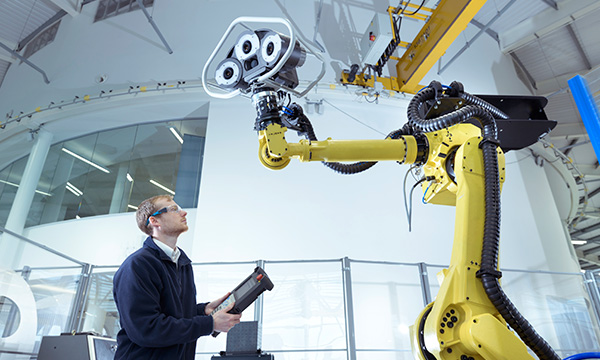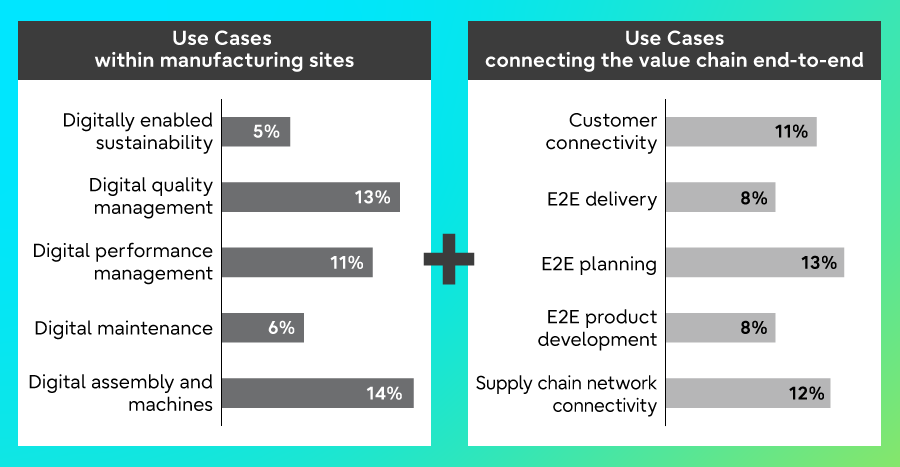Digital Transformation in Manufacturing: Top challenges CxOs face and proven solutions
Part 2: The next 10 years - the challenge to transition to Industry 5.0
As we have seen in Part 1, when smart manufacturing was first proposed 10 years ago the goal was to improve productivity, create new business, and provide new customer value through digital technology. However, with the socioeconomic environment undergoing such massive change, it has become essential to build out the new functionality of smart manufacturing.
Part 2 will introduce the functions that will become indispensable for the future of the manufacturing industry in the next decade, along with examples of forward-thinking enterprises that can serve as role models.

- Composability and sustainability required for smart manufacturing in the future
- The growing importance of sustainability
- Role models for smart manufacturing: Global Lighthouses
- Global Lighthouse characteristics
- Smart manufacturing shifting focus to the entire value chain (E2E)
- Lighthouses are quantitatively assessed using KPIs
Composability and sustainability required for smart manufacturing in the future
Gartner proposed the concept of a "composable business,” based on the success factors of the frontrunner companies that responded quickly to the pandemic. Gartner defines a composable business as one that is architected for “real-time adaptability and resilience in the face of uncertainty.” Table 1 shows Gartner’s summarization of the functions that are required for a composable business to respond to environmental changes in times of uncertainty.
Table 1 Functions required of a composable enterprise
| Traditional business
(Organization) | |
|---|---|
| Strategy | Long-term |
| Customer | Siloed |
| (Owner of) Value | Enterprise |
| Technologies | Static |
| Workforce | Human |
| Operations | Stable |
| Composable Business
(Organization) |
| Continuous (change) |
|---|
| Unified |
| Ecosystem |
| Composable |
| Human and Machine |
| Adaptive |
Gartner proposes a methodology based on four principles and three building blocks for transforming a business into a composable enterprise.
- Discovery
- Modularity
- Orchestration
- Autonomy
- Composable thinking
- Composable business architecture
- Composable technologies
DX focuses on transformation via digital means, but does not delineate the organizational structure to be targeted. The concept of a ‘composable business’ involves both the vision for a resilient organization and the means to achieve it. A composable business could be described as a developed form of DX.
Three ways that composability cuts costs
- The entire system can be developed very quickly.
- Components can be arranged in a variety of ways by combining the internal modules.
- The advantages of standardization and reuse can be leveraged.
Especially in the area of software and applications, no-code/ low-code development technologies are increasing in popularity and adoption, along with API development automation needed for collaboration between modules. This makes application development easier and facilitates lower-cost system implementation. These points are considered to have a "two birds with one stone" effect on the spread of smart manufacturing.
In fact, some companies are already putting them into practice. For example, in the FY2022 edition of the Fujitsu Technology and Service Vision (FT&SV)![]() , which describes Fujitsu's transformation and shares insights on building a sustainable society, Fujitsu gives insights in line with trends in composable architecture, writing that “in the future businesses will shift from creating their own new cloud-native applications to quickly connecting and combining various services”. As a DX partner to its customers, Fujitsu has begun to utilize and implement ecosystems with the aim of creating a Component as a Service business model that will deliver applications that grow as a result of reusing know-how and combining components.
, which describes Fujitsu's transformation and shares insights on building a sustainable society, Fujitsu gives insights in line with trends in composable architecture, writing that “in the future businesses will shift from creating their own new cloud-native applications to quickly connecting and combining various services”. As a DX partner to its customers, Fujitsu has begun to utilize and implement ecosystems with the aim of creating a Component as a Service business model that will deliver applications that grow as a result of reusing know-how and combining components.
Recent years have seen growth in manufacturing methods that are relatively compatible with digital technology, including industrial structural change in the automotive industry (EVs), manufacturing process innovation through Tesla's single-piece (unibody) casting, the emergence of digital native manufacturing technologies such as 3D printer technology, and the deployment of AI in manufacturing processes. For example, at Tesla, large-scale casting (megacasting) and integration of components has reduced complexity in production by slashing the 171 parts originally required for the Model 3 to just two parts for the body structure of the Austin-built Model Y vehicle, thereby requiring 1,600 fewer welds. In addition, the number of robots on the production line at the new factory in Austin, Texas, has been reduced by more than 70% per production capacity compared to the number originally required for the Model 3 production line. This simplification or modularization of processes in the real world simplifies IT system interoperability.
As a result, the integration of IT and OT is expected to continue through technological and IT innovations in the real world, lowering the barriers to the future growth of smart manufacturing.
The growing importance of sustainability
Another important requirement of smart manufacturing is the implementation of sustainability. Many factors have contributed to the international community and the business community starting to take sustainability seriously. These include the sense of urgency toward achieving the UN's SDGs, the progress achieved since the declaration of carbon neutrality by many countries and their progress on the Paris Agreement, the rapid response to the pandemic, and social dissatisfaction with the technological monopoly and huge income disparity resulting from the winner-takes-all model that has emerged as a corrupting effect of rapid digitalization. The abovementioned initiatives by Germany, the EU and WEF are a response to these demands. The EU has identified the following six technology areas that support Industry 5.0:
- Individualized human-machine-interaction
- Bio-inspired technologies and smart materials
- Digital twins and simulation
- Data transmission, storage, and analysis technologies
- Artificial intelligence
- Technologies for energy efficiency, renewables, storage and autonomy
Most of these technology areas are digital technologies themselves or technologies that require digital support. Industry 4.0 and 5.0 both agree on the use of digital technology as a tool.
In terms of technology, the EU's Industry 5.0 concept encourages the use of advanced digitalization, big data and AI for next-generation industries. At the same time, it demands that suitable technologies be deployed for workers and argues that workers should not become ‘slaves’ to technology. There are many trade-offs between the deployment of advanced digital technologies and their suitability for workers. In this sense, the abovementioned low-code/no-code technologies and composable approaches are truly worker-friendly technological approaches that are in line with the delivery of human-centric value, and further technological innovation is expected in the future.
In this way, society is beginning to look to industries empowered by digital technology to solve the world’s problems. Regulators, including the EU, will further encourage industry to redouble its efforts, and will doubtless implement policies with incentives to grant benefits or impose penalties. This move is expected to have a significant impact on global business management.
Role models for smart manufacturing: Global Lighthouses
What would it take for companies to successfully leverage digital to drive smart manufacturing? WEF has remained focused on transforming manufacturing via next-generation digital technologies (4IR technologies) since the 2010s. Given that the global manufacturing industry has been slow to embrace DX, WEF, in collaboration with McKinsey & Company, launched the Global Lighthouse Network in 2018 to identify the world’s leading DX companies and create DX role models on a global scale. As of July 2022, the Network had 103 members. In September 2021, WEF also began identifying Sustainability Lighthouses, that is, sustainability pacesetters from across the Global Lighthouse Network, and as of July 2022 had designated a total of six.
Global Lighthouse characteristics
What types of company are chosen as lighthouses? To be designated a Lighthouse by WEF, companies must first self-apply for selection. While WEF does not publish quantitative criteria for selection, it does publish the following qualitative criteria:*6
A Lighthouse is a factory that has adopted fourth industrial revolution (4IR) technologies, from pilots to large-scale integration, and as a result has achieved significant financial and operational results (results are quantitatively verified against the KPIs discussed below).
- Has achieved a significant impact
- Has successfully integrated several use cases
- The technology platform is scalable
- Has demonstrated strong performance in key drivers such as management transformation, capacity building, and collaborating with communities in the fourth industrial revolution
Actual selection is conducted by a committee of stakeholder private sector organizations, university academics, and renowned 4IR technology experts, and includes site visits.
The 103 lighthouses mentioned above are deploying approximately 143 use cases (excluding duplicate cases). Figure 2 categorizes the use cases deployed by the lighthouses, dividing them into two types of deployment: those within manufacturing sites and those that connect the value chain end to end (E2E).
Figure 2 Classification of use cases deployed by WEF Lighthouses (within manufacturing plants; throughout the value chain)

Smart manufacturing shifting focus to the entire value chain (E2E)
The number of E2E deployments (about 75 use cases) is larger than the number of deployments within manufacturing plants (about 68 use cases). This would seem to indicate that smart manufacturing has shifted from an approach centered on improving productivity in manufacturing plants to an approach centered on creating value for the entire value chain (E2E), plants included. The following three factors are considered to be behind this shift:
- Digital native consumers have become the primary form of consumer. Their needs have shifted from wanting to experience the traditional quality of goods to experiencing design, smartness, and other forms of value, requiring total value provision throughout the value chain.
- Growing uncertainties (e.g., pandemic and geopolitical risks) clouding the business environment have increased the need for resilient E2E supply chains.
- Digital technologies such as AI, cloud, blockchain and 5G, which are enablers of E2E connectivity, are in the diffusion phase.
Against this backdrop, activities to drive smart manufacturing have been elevated from the dimension of in-factory management to that of business management and have become a theme that should presumably be addressed by the entire management team rather than a single factory manager or the IT department.
In fact, frontrunner companies are maximizing the effects of DX by simultaneously adding in factory floor use cases and E2E use cases. For example, Johnson & Johnson Vision Care bundles the following main five use cases:
- Digital customer collaboration
- E2E visualization and real-time tracking
- Process automation/Logistics/AGV
- Adaptive process control and vision system
- Intelligent material handling and tracking
Johnson & Johnson’s initiative scales up across the value chain, extending DX beyond production sites by reaching out to the order supply chain (upstream) and their customers (downstream).
In addition, Schneider Electric, a global manufacturer of electrical and industrial equipment, is deploying the following main five use cases at its headquarters manufacturing site in France:
- E2E planning and scheduling
- Digital performance management
- Digital/Analytics energy management
- Digital maintenance/scrap reduction
- Automation and operator capacity expansion
Since launching the lighthouse case study at its headquarters, Schneider Electric has been scaling up through widespread deployment of know-how to its own sites in the U.S., China, Mexico, and Indonesia. By fostering the transformation of its entire site network on a broader scale, this initiative is accelerating DX and successfully expanding Schneider Electric’s own lighthouse network. It grew from just five sites in 2017 to more than 80 by 2021.
The cases of Johnson & Johnson Vision Care and Schneider Electric are thought-provoking role models; they are examples of scaling up smart manufacturing from both the value chain and organizational perspective to magnify effectiveness.
Lighthouses are quantitatively assessed using KPIs
WEF lighthouse assessment is not limited to mere technical feasibility, but also quantitatively identifies the impact on corporate management performance and sustainability. As Table 2 shows, the KPIs employed as the WEF assessment axis consist of five major categories and 17 minor categories. While there is variation in the impact confirmed by each lighthouse, the expected results can be verifiably achieved if well implemented. Having obtained such clear data about impact is encouraging for other companies engaging in smart manufacturing.
Table 2 Operational and environmental impacts of the Lighthouse digital journey
| KPIs (Major category) | KPIs (Minor category) | Confirmed Impact (Effect) |
|---|---|---|
| Sustainability | Greenhouse gas (GHG) emissions reduction | 8-97% |
| Waste reduction | 4-80% | |
| Water consumption reduction | 5-75% | |
| Energy efficiency | 1-100% | |
| Productivity | Factory output increase | 2-124% |
| Productivity increase | 3-400% | |
| OEE (Overall Equipment Effectiveness) increase | 2-84% | |
| Product cost reduction | 4-70% | |
| Operating cost reduction | 1-92% | |
| Quality cost reduction | 2-100% | |
| Agility | Inventory reduction | 5-100% |
| Lead-time reduction | 10-99% | |
| Change-over shortening | 11-100% | |
| On-time delivery increase | 1-30% | |
| Speed to market | Speed-to-market reduction | 10-89% |
| Design iteration time reduction | 2-98% | |
| Customization | Lot size reduction | 4-100% |
It is worth noting that WEF's lighthouse impact verification process is continually improving its KPIs. In particular, the sustainability indicators have been improved. Energy efficiency was adopted as one of the Agility indicators in the initial set of 2018 verification indicators, but by the end of 2019, subcategories such as waste reduction and water consumption reduction had been added. In addition, in March 2021, CO2 emissions reduction was added, and in September 2021, greenhouse gas emissions reduction was also added. In September 2021, three of the 90 lighthouses were designated Sustainability Lighthouses to recognize their impressive eco-efficiency. By March 2022, three more companies were added to the list, bringing the total number of designated Sustainable Lighthouses to six.
- Demand chain agility and consumer-centricity
- Supply chain resilience
- Productivity and speed at production sites
- Production efficiency
In fact, 64% of Lighthouses are bundling use cases to have a positive impact on eco-efficiency. WEF has revealed that by embracing digital technologies, Sustainable Lighthouses demonstrate that sustainability and competitive excellence can be interwoven.
Table 3 lists exemplars of use cases deployed by Sustainable Lighthouses, which may be described as developed forms of DX Lighthouse. All of these use cases are solutions that not only utilize digital technology but also achieve a balance between digitalization and sustainability, thereby serving as aspirational reference examples for other companies.
Table 3 Typical examples of use cases deployed by Sustainable Lighthouses
| Examples of use cases | |
|
|
|
|
|
|
|
|
|
|
However, the eco-efficiency outcomes revealed by the 64% of Lighthouses are known to be more the result of pursuing other goals such as production efficiency, rather than the result of working toward a clear goal. In this sense, WEF's Sustainability Lighthouse Assessment Initiatives are a call to companies to look at more sustainable goals.
The WEF report, published in March 2022, raises the concept of responsible transformation (RX), and adds the environmental, social and governance (ESG) elements of workforce engagement and governance to the concept of sustainability, with eco-efficiency at its core. WEF describes this as reflecting the growing commitment to combating climate change and the unprecedented importance of ESG due to the cataclysmic changes in the global business environment wrought by the pandemic and other factors. This seems to be in line with the thinking of Germany and the EU.
References
- John Dyck (October 2021). Robot revolution & industrial IoT initiative - Partnering to drive interoperability and harmonization.
- METI (December 2020). DX Report 2 (Interim Report)
- BMWi (October 2019). 2030 Vision for Industrie 4.0 - Shaping digital ecosystems globally
- Molex (2021). The state of Industry 4.0: A survey of industrial manufacturing stakeholders
- METI Japan (2022). FY2021 Fact-finding survey on core manufacturing technologies: Challenges and responses in Japan's manufacturing industry
- WEF (January 2019). Fourth Industrial Revolution: Beacons of Technology and Innovation in Manufacturing.
- BMWi (November 2020). Sustainable production: Actively shaping the ecological transformation with Industrie 4.0
- CESMII (May 2022). 2022 Smart Manufacturing Market Survey
- European Commission (January 2021). Industry 5.0: Towards a sustainable, humancentric and resilient European industry
- European Commission (December 2021). Industry 5.0: A Transformative Vision for Europe. ESIR Policy Brief No. 3
- John Dyck (October 2021). Partnering to Drive Interoperability and Harmonization
- McKinsey Global Institute (May 2022). Securing Europe’s future beyond energy: Addressing its corporate and technology gap
- McKinsey & Company, ACCJ (February 2021). Japan Digital Agenda 2030
- Monika Sinha (2021). The Gartner 2022 CIO Agenda: Make Composability Your Superpower
- WEF (September 2021). Global Lighthouse Network: Unlocking Sustainability through Fourth Industrial Revolution
- WEF (March 2022). The Global Lighthouse Network Playbook for Responsible Industry Transformation
- METI Web (2022). Material from Study Group Working toward the Transformation to a Digital Industry
About the author

Dr. Jianmin Jin
Chief Digital Economist, Marketing Transformation Division, Global Marketing Unit.
Dr.Jin is engaged in mega trends insights of global political, economic, social and technology (PEST), and the research and analysis of advanced cases of digital innovation / digital transformation (DX).
Dr.Jin’s latest book is "Towards the Creation of the Japanese Version of Silicon Valley: Ecosystem Innovation Learned from Shenzhen" (Co-authored).




